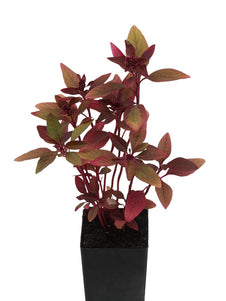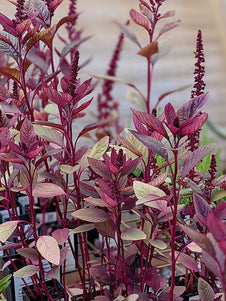



Amaranth Garnet Red
Amaranth Garnet Red
- In stock, ready to ship
- Inventory on the way

Usually available: September to March
Life cycle: Annual
Height: 1.6m
Position: Full sun
Soil preference: Well drained
This is how we pack and send your Herb Plants to all states except TAS & WA
You will receive
- 1 Amaranth Garnet Red Herb Plant in a 50 X 75mm tube - General growing instructions
All of our Herb Plants are grown organically with certified organic potting mixes and fertilizers
Botanical Name: Amaranthus tricolour
Amaranth ‘Garnet Red’ is a cultivar of the Amaranth tricolour species with a deep, intense crimson red colouring. Although it is an annual plant, it can quickly reach up to 1.6 meters producing a striking garden display. It is the most intensely coloured amaranth and produces the best colour in very warm conditions. The leaves are red tinged on the darkish grey-green surface and a deeper red underneath. The veins also appear red and the colour intensifies with the heat. The long lasting, blooms are presented on long straight stems, extending upwards in spear like, crimson plumes.
There are many varieties of Amaranth, many with similar features, culinary or garden uses and growing conditions. For further descriptive information on the Amaranthus genus please see Amaranth Edible Red.
Growing Conditions
As a comparison, Garnet Red, is more vigorous than the Edible Red Amaranth and may reach 1.6 meters in height. It is drought hardy once established and requires full sun for at least 6 hours a day. The seeds should be sown in spring and can be started in an indoor seed raising tray earlier, if kept warm enough. The seeds require a soil temperature of at least 20 C to germinate. Sow or plant out with spacing of 10 inches and water well until the plants are established. It takes 55 days from seed to harvest but young leaves can be picked from as early as 25 days. Flowers should appear on straight stems from mid-summer until the weather grows too cold and/or frosty. The colours should become more intense as the plant ages.
Further information about growing conditions shared by the many members of the Amaranthus genus may be found at Amaranth Edible Red and Amaranth tricolour.
Culinary Uses
Amaranth Red Garnet may be used in the same way as Edible Red Amaranth for a variety of culinary purposes. It has the same high nutritional value and the added benefit of being able to be harvested sooner. Experts suggest using Red Garnet in 3 or even 4 stages. Firstly, the young sprouts or micro greens may be used and they are red even at this stage. Secondly, the young tender leaves may be used as nutritious small salad greens or ‘reds’ in this case, where they provide an excellent leaf display. Thirdly, the larger leaves may be used as a spinach replacement in the same manner as other amaranths. And, the fourth use is as the seed and grain. Although, you may not produce very much seed, it may still be used in small ways by including it in cereals or breads. However, failing this, the plant can be let to go to seed which will provide a new crop the following year and enable the local birdlife to have a feast.
Medicinal Uses
The general use of amaranth today is ornamental and edible, with limited use for health maintenance. Amaranth contains tannins and some varieties of amaranth have had some traditional use as astringents and tonics, for example a mouth gargle for mouth ulcers or digestive concerns.
Other Uses
Amaranth is also used for creating dyes that are used for colouring food and medicines. The whole plant produces green and yellow dyes, but that part of the plant that produces the red dye is unknown.
All information provided on this website is for informational purposes only. Please seek professional advice before commencing any treatment.





